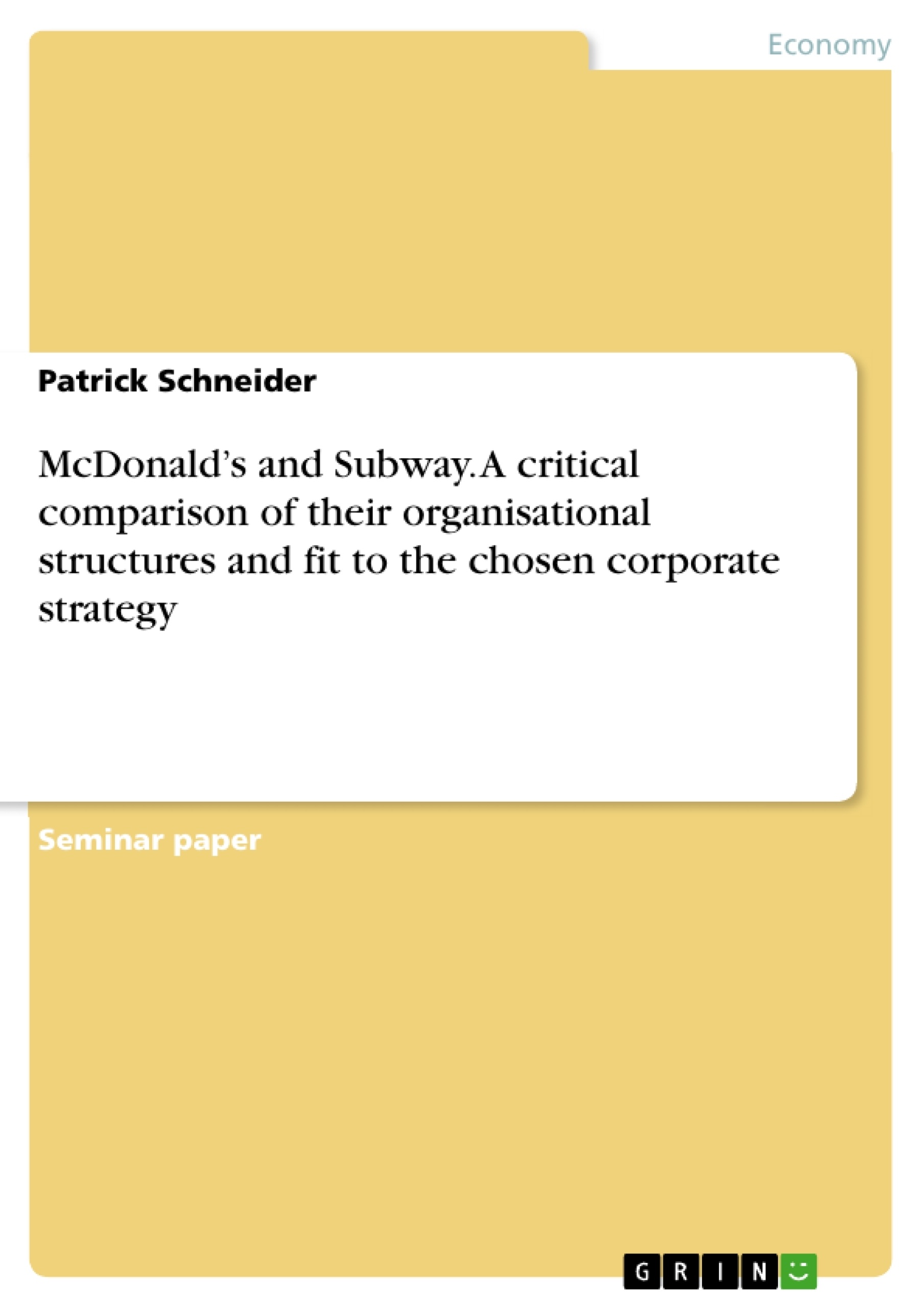This assignment is answering the task to "compare the organisational structure of two direct competitors in an industry of your choice. To what extent and how does the chosen organisational structure reflect the specific corporate strategy of these companies? Discuss the respective structures critically". The assignment is comparing McDonald's and Subway, the two main competitors in the fast food industry. The chosen companies are the two market leaders in the fast food industry. Since Hill and Jones point out that a corporate strategy formulation comes first followed by designing the organisational structure, the following sections will describe the corporate strategies of both companies first. Later on, it will be evaluated critically what kind of organisational structure each of the competitors are built on and which one has the better fit with regard to their strategy. In the end, concluding remarks and an outlook will be provided.
The organisational structure of any company can be understood as a vehicle that depicts the activities and connections of various divisions, business units and functions of that company. It helps managers to comprehend and to control the flow of activities. The organisational structure is highly important to be established appropriately because it presets the paths on which a company can create value and ultimately determines the efficiency of the value chain. There are various problems that can come up especially in large companies like a lack of coordination, information distortion and motivational problems. The weaknesses of a organisational structure are to be kept in mind when setting up a corporate strategy or else the structure needs to undergo changes in order to follow the strategy. The fit between a chosen corporate strategy and the structure of an organisation has an important influence on how smooth the different organs of a companys can work together to fulfil the corporates objectives.
Table of Contents
- Introduction.
- Company backgrounds
- McDonald's company background.
- Subway's company background.
- Corporate strategies.
- McDonald's corporate strategy
- Subway's corporate strategy.
- Organisational structures.
- McDonald's organisational structure.
- Subway's organisational structure.
- Comparison of the competitors organisational structure.
- How good do the structures reflect the corporate strategies of the competitors?
Objectives and Key Themes
This assignment critically analyzes the organisational structures of McDonald's and Subway, two major players in the fast food industry, and investigates how effectively these structures support their respective corporate strategies. The analysis aims to determine the extent to which the chosen organisational structures reflect the companies' specific strategic goals. The comparison will highlight key areas of congruence and divergence between the two companies' approaches.
- Organizational Structure and Strategy Fit
- Corporate Strategy Formulation and Implementation
- Organizational Structure and Value Chain Efficiency
- The Importance of History and Background in Organizational Design
- The Role of Structure in Achieving Corporate Objectives
Chapter Summaries
- The introduction establishes the importance of organisational structure in a company's success, particularly in large corporations like McDonald's and Subway. It highlights the crucial link between corporate strategy and organisational structure, emphasizing the need for a strong fit between the two to achieve organizational effectiveness.
- This chapter explores the historical backgrounds of both McDonald's and Subway, providing context for their respective organizational structures. It delves into the evolution of both companies, tracing their growth from humble beginnings to their current global prominence in the fast-food industry. By examining the historical trajectory of each company, this chapter sets the stage for understanding how their structures have been shaped by their past experiences and strategic choices.
- This section delves into the corporate strategies of both McDonald's and Subway. It examines their strategic goals, target markets, and competitive advantages. The chapter analyzes how each company positions itself within the fast-food industry and how their strategic choices influence their organizational structures.
- This chapter focuses on the organizational structures of McDonald's and Subway. It examines the key elements of their structures, including their division of responsibilities, reporting lines, and decision-making processes. The chapter analyzes the strengths and weaknesses of each company's structural design in relation to their strategic goals and operational needs.
Keywords
This study focuses on the organizational structures of McDonald's and Subway, examining how these structures align with their respective corporate strategies. Key terms include: organizational structure, corporate strategy, value chain, fast-food industry, strategic fit, organizational design, and competitive advantage.
- Quote paper
- Patrick Schneider (Author), 2019, McDonald’s and Subway. A critical comparison of their organisational structures and fit to the chosen corporate strategy, Munich, GRIN Verlag, https://www.grin.com/document/464712



